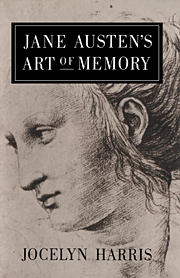Book contents
- Frontmatter
- Contents
- Preface
- 1 Northanger Abbey
- 2 The return to Richardson
- 3 Sense and Sensibility
- 4 Pride and Prejudice
- 5 Mansfield Park
- 6 Emma
- 7 Persuasion
- Conclusion: ‘Nothing can come of nothing’
- Appendix 1 The History of Sir Charles Grandison
- Appendix 2 Sir Charles Grandison in the juvenilia
- Notes
- Bibliography
- Index
- Frontmatter
- Contents
- Preface
- 1 Northanger Abbey
- 2 The return to Richardson
- 3 Sense and Sensibility
- 4 Pride and Prejudice
- 5 Mansfield Park
- 6 Emma
- 7 Persuasion
- Conclusion: ‘Nothing can come of nothing’
- Appendix 1 The History of Sir Charles Grandison
- Appendix 2 Sir Charles Grandison in the juvenilia
- Notes
- Bibliography
- Index
Summary
Jane Austen read very extensively in history and belles-lettres, and her memory was extremely tenacious. Her invention sprang largely from books, for in the English classics that were once women's liberal education, Jane Austen found languages to write with. I here set her books against other books to show how memory gives origins to art, and without claiming to have discovered everything, explore how her mind might have worked.
Jane Austen uses ‘allusions’ and ‘influences’ neither by chance nor merely for embellishment. Northanger Abbey for instance, far from being the slightest of her novels, dramatises Locke to display a method and a manifesto. This, the first of her longer works to be completed in 1803, seems virtually unaffected by Richardson, whom she had satirised ruthlessly in the juvenilia. The 1804 publication of his Correspondence may have revived her respect for a favourite author, because difficult critical cruxes in Sense and Sensibility disappear if Jane Austen built her book on Pamela, Carissa, and Grandison, and if she was prompted by the Correspondence to revise her novel in the ‘lost years’ 1805–9, as I shall argue. Sense and Sensibility contains particularly nice contrasts between some scenes she fully reworked from Richardson and Milton, and others she hardly assimilated at all. Pride and Prejudice demonstrates the dazzling variety of ways in which she rewrote Grandison, along with glances towards Pamela and Much Ado about Nothing.
- Type
- Chapter
- Information
- Jane Austen's Art of Memory , pp. ix - xiiPublisher: Cambridge University PressPrint publication year: 1989



